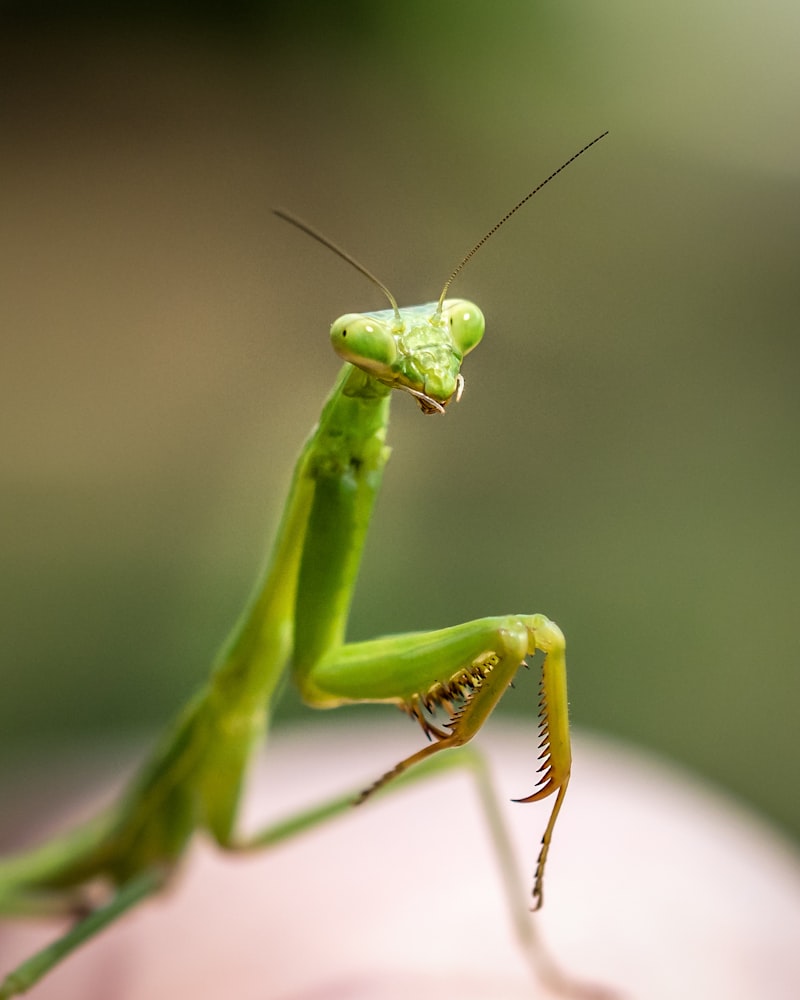Ever wondered what makes insects so aggressive? The neurobiology behind aggression in these tiny creatures is as fascinating as it is crucial for their survival. Insects, despite their size, exhibit behaviors that are driven by complex neural mechanisms.

At the heart of insect aggression lies their nervous system, specifically the intricate network of neurons and neurotransmitters that govern their responses to stimuli. When provoked, insects like ants or bees don’t just react instinctively; their brains orchestrate a series of chemical reactions that dictate their aggressive behavior.

One key player in this neurobiological drama is serotonin, often dubbed the “happiness hormone” in humans. In insects, however, serotonin plays a pivotal role in regulating aggression. Studies have shown that manipulating serotonin levels can significantly alter an insect’s aggression towards others of its kind or even towards predators.
But it’s not just serotonin; octopamine, another neurotransmitter, also wields significant influence over insect aggression. Known for its role in modulating various behaviors, octopamine levels can ramp up or suppress an insect’s aggressive tendencies depending on the situation.
Moreover, the structure of an insect’s brain itself contributes to how aggression manifests. Different regions of the brain, connected through intricate neural circuits, process sensory information and coordinate responses that could range from territorial defense to competition for resources.
The neurobiology of aggression in insects is a multifaceted subject that blends chemistry, neuroscience, and behavior. Understanding these mechanisms not only sheds light on how insects interact with their environment but also provides insights into broader biological principles that could potentially be applied to other species, including humans.
Unraveling the Brain: Neurobiology of Aggression in Insects
Ever wondered why insects sometimes act so aggressively? The neurobiology of aggression in insects is a fascinating area of study that sheds light on their complex behaviors. Unlike humans, insects lack the sophisticated brain structures we possess, but that doesn’t mean they don’t have their own intricate systems to regulate behavior.
At the heart of insect aggression lies their nervous system. Much like a miniature command center, the insect brain coordinates various signals and responses that dictate how they interact with their environment and each other. When it comes to aggression, this tiny brain plays a crucial role.
One of the key players in insect aggression is serotonin, often dubbed the “feel-good” neurotransmitter. Surprisingly, in insects, serotonin can have quite the opposite effect—it can heighten aggression. Imagine if every time you felt good, you also felt more inclined to pick a fight! For insects, serotonin levels can influence whether they exhibit aggressive behaviors or not.
But it’s not just serotonin; other neurotransmitters like octopamine also play vital roles. Octopamine, similar to adrenaline in humans, ramps up their readiness for action. It’s like insects are constantly on edge, ready to defend or attack at a moment’s notice.
The sensory inputs insects receive also contribute significantly to their aggressive tendencies. For instance, if an insect feels threatened by a competitor invading its territory or a predator approaching, sensory signals are sent to their brain. These signals trigger a cascade of neural responses that culminate in aggressive behaviors aimed at self-preservation.
Interestingly, aggression in insects isn’t always about defense. Sometimes, it’s about competition for resources like food or mates. Just like in a high-stakes game, insects may resort to aggressive behaviors to ensure their survival and reproductive success.
Understanding the neurobiology of aggression in insects offers insights not just into their behavior, but also into our own evolutionary past. By studying how these tiny creatures manage their aggression, scientists gain valuable clues about the deeper origins of aggression in all animals, including humans.
So next time you see ants battling over a crumb or bees fiercely defending their hive, remember—it’s not just about survival; it’s about the intricate dance of neurotransmitters and sensory signals that govern their behavior.
Inside the Insect Mind: How Neurobiology Shapes Aggressive Behavior
Ever wondered what drives the aggressive behavior of insects? It’s not just instinct; it’s a fascinating interplay of neurobiology and environmental cues that shape their actions. Insects, despite their tiny size, exhibit surprisingly complex behaviors that are deeply rooted in their neural makeup.
At the heart of their aggression lies the intricate wiring of their nervous systems. Unlike humans, insects lack a centralized brain; instead, they have clusters of neurons called ganglia distributed throughout their bodies. These ganglia communicate with each other and with sensory organs, forming a decentralized yet effective network that governs behavior.
One of the key players in insect aggression is serotonin, often dubbed the “happiness hormone” in humans. In insects, serotonin plays a pivotal role in modulating aggression, influencing how they respond to threats and challenges in their environment. Studies have shown that altering serotonin levels can significantly impact an insect’s aggression levels, highlighting its importance in their behavioral repertoire.
But aggression in insects isn’t solely dictated by neurochemistry. Environmental factors also play a crucial role. From territorial disputes to competition for resources, insects face constant pressures that trigger aggressive responses. These behaviors are finely tuned adaptations that enhance their survival and reproductive success in their respective habitats.
Think of an ant colony defending its territory or a wasp fiercely protecting its nest—these actions are not random but are driven by a complex interplay of neural signals and environmental stimuli. Understanding the neurobiological underpinnings of insect aggression not only sheds light on their behavior but also offers insights into broader questions of animal behavior and evolutionary biology.
The aggressive behaviors we observe in insects are a testament to the intricate workings of their neurobiology. By delving deeper into their neural mechanisms and behavioral responses, researchers can unravel the mysteries of aggression across the animal kingdom, offering new perspectives on adaptation, survival, and the diversity of life on Earth.
The Science Behind Insect Aggression: A Neurobiological Perspective
Insects, despite their tiny size, exhibit a wide range of behaviors that include aggression. This behavior is not random but rather deeply rooted in their neurobiology. Researchers have discovered that aggression in insects is largely governed by their nervous systems and hormonal balances.
At the core of insect aggression lies the intricate interplay of neurotransmitters within their brains. Just like humans, insects have neurotransmitters such as serotonin and dopamine that play crucial roles in regulating their behaviors. These neurotransmitters can influence how aggressive or docile an insect might be in response to various stimuli.
For instance, when an insect perceives a threat or competition for resources, its brain releases specific neurotransmitters that trigger aggressive behaviors. This response is often instinctual and crucial for survival in competitive environments where resources are limited.
Moreover, studies have shown that the size and structure of certain brain regions in insects can also affect their aggression levels. In species where aggression is more pronounced, researchers have observed larger neural circuits associated with aggression-related behaviors.
Interestingly, aggression in insects can also be influenced by external factors such as temperature, humidity, and even the presence of certain chemicals in their environment. These factors can alter the expression of genes related to aggression or directly affect neurotransmitter levels, thereby influencing behavior.
Insect Wars: Exploring Neurobiology’s Role in Aggressive Behavior
Ever wondered how tiny insects engage in fierce battles that seem straight out of a science fiction movie? The answer lies in their intricate neurobiology. Insect wars, while often overlooked, showcase a fascinating display of aggressive behavior driven by their neural mechanisms.
Insects, from ants to beetles, engage in combat for various reasons: territory, resources, or even mates. This behavior is not just mindless fighting but a strategic display of their neurobiological adaptations. Within their minuscule brains, specific neural circuits govern aggression, triggering responses to perceived threats or challenges.
Take ants, for instance. Their colonies function as organized armies where each member plays a crucial role. When threatened, ants release alarm pheromones that signal danger, instantly triggering aggressive responses from their peers. This rapid communication and coordinated attack highlight the sophisticated neural pathways at play.
Beetles, on the other hand, rely on a different set of neurobiological triggers. Studies have shown that aggression in beetles can be linked to hormonal changes and environmental cues. During mating seasons or when defending food sources, beetles exhibit heightened aggression, driven by fluctuations in neurotransmitter levels within their brains.
The neurobiology behind insect aggression also parallels human responses in intriguing ways. Analogous to adrenaline in humans, insects release neurotransmitters like octopamine to enhance their combat readiness. This chemical surge not only sharpens their senses but also suppresses pain, allowing them to engage in intense battles without hesitation.
Understanding the neurobiological underpinnings of insect aggression isn’t merely academic curiosity. It sheds light on evolutionary strategies and ecological dynamics. By studying these mechanisms, scientists gain insights into broader behaviors across species and potentially develop innovative pest control strategies that are more targeted and effective.
Insect wars unveil a hidden world where neurobiology orchestrates intricate battles. From ants’ colony-wide strategies to beetles’ hormone-driven conflicts, each skirmish underscores the complexity of neural circuits in shaping aggressive behavior. As researchers delve deeper into this fascinating realm, new discoveries promise to unlock even more secrets of nature’s relentless drive for survival.
From Instinct to Neurons: Understanding Insect Aggression Neurobiology
Insects, despite their size, exhibit remarkable aggression that is essential for survival and reproduction. This aggression is not merely random but finely tuned by their neurobiological makeup. At the heart of this behavior are neurons, the fundamental units of the insect nervous system. These neurons orchestrate responses to stimuli, triggering complex behaviors like aggression in response to specific cues.
Understanding insect aggression neurobiology starts with the sensory inputs that insects receive from their environment. Whether it’s the chemical signals left by a rival ant colony or the visual recognition of a potential threat, insects interpret these cues through specialized sensory organs. These signals are then processed by their nervous system, where neurons play a pivotal role in translating sensory inputs into behavioral outputs.
Neurotransmitters, the chemical messengers of the nervous system, also play a crucial role in modulating insect aggression. For instance, serotonin levels can influence an insect’s propensity towards aggression, while dopamine may reinforce aggressive behaviors in certain contexts. These neurotransmitters act within neural circuits, intricate networks of neurons that coordinate different aspects of behavior.
The genetic basis of insect aggression is equally intriguing. Studies have identified specific genes that regulate aggression-related behaviors in insects. These genes encode proteins involved in neurotransmitter synthesis, receptor function, and neural development, providing a genetic framework for understanding the diversity of aggression seen across insect species.
In summary, insect aggression neurobiology bridges the gap between instinct and neuronal mechanisms. It illustrates how tiny creatures with minuscule brains can exhibit such sophisticated and adaptive behaviors. By unraveling the complexities of their neurobiology, researchers gain insights into broader questions about behavior, evolution, and the fundamental principles of neural function in all animals.
Neurological Warriors: Decoding Aggression in Insect Brains
Aggression in insect brains is not merely a random act but a finely tuned response to various stimuli in their environment. From territorial disputes to resource competition, insects rely on aggression as a survival strategy encoded within their neural circuits. These behaviors are orchestrated by specialized regions of their tiny brains that process sensory information and trigger appropriate responses.
Researchers have uncovered that aggression in insect brains involves a delicate balance of neurotransmitters and neuropeptides, acting as chemical messengers that modulate behavior. For instance, serotonin levels can influence whether an insect engages in aggressive encounters or adopts a more passive stance. Similarly, octopamine plays a crucial role in regulating aggression, affecting how insects perceive and respond to threats.
The study of aggression in insect brains offers insights into broader evolutionary questions about behavior and adaptation. It underscores the sophisticated nature of insect cognition, challenging traditional views of these creatures as mere automatons. Instead, insects exhibit nuanced behaviors that reflect their ability to assess risks, make decisions, and adapt to changing circumstances—all guided by their intricate neural networks.
Understanding aggression in insect brains not only sheds light on their survival strategies but also holds implications for pest management and ecological balance. By deciphering the neural mechanisms behind aggressive behaviors, researchers aim to develop targeted strategies that could potentially mitigate conflicts or harness these behaviors for beneficial purposes.
The exploration of aggression in insect brains reveals a rich tapestry of neurobiological complexity. It highlights how these tiny creatures navigate their world through sophisticated neural processes, showcasing the marvels of nature’s design at the microscale.
The Battle Within: Neurobiology’s Influence on Insect Aggression
At the heart of this battle lies the insect brain, a marvel of efficiency honed by millions of years of evolution. Unlike humans, insects lack the complex cortical structures we rely on for decision-making. Instead, their behaviors are driven by smaller clusters of neurons that efficiently process sensory inputs and trigger responses with lightning speed.
Take, for instance, the defensive behaviors of ants. When threatened, they release alarm pheromones that rally their colony mates into action. This rapid mobilization isn’t just a reflex—it’s a calculated response orchestrated by their neural circuits. These circuits integrate sensory cues from the environment, such as chemical signals or visual stimuli, and coordinate the appropriate behavioral response, whether it’s to attack, flee, or communicate.
Neurotransmitters play a pivotal role in modulating insect aggression. Chemical messengers like serotonin and dopamine influence mood and behavior in humans, and insects have their own versions that regulate aggression. For example, in fruit flies, serotonin levels can affect their fighting behavior, with higher levels correlating to increased aggression.
The genetic blueprint of insects also shapes their propensity for aggression. Researchers have identified specific genes that influence aggression-related behaviors, such as aggression towards rivals or cooperation within colonies. These genes encode proteins that regulate neuronal development or neurotransmitter function, providing a molecular basis for understanding insect aggression.
Frequently Asked Questions
How do environmental factors affect insect aggression?
Learn how environmental factors influence insect aggression, exploring key factors like temperature, habitat conditions, and resource availability.
What role do neurotransmitters play in insect aggression?
Neurotransmitters in insect aggression: Learn about the pivotal role neurotransmitters play in influencing aggression levels in insects. Understand how these chemical messengers affect behavior and how researchers study their impact on insect interactions.
How do pheromones influence insect aggression?
Learn how pheromones impact insect aggression with our concise guide. Understand the chemical signals that trigger aggressive behavior in insects, influencing their interactions and survival strategies.
What neural mechanisms drive aggression in insects?
Aggression in insects is driven by neural mechanisms involving specific brain regions and neurotransmitters. Key factors include sensory inputs, neural circuits in the brain, and hormonal influences that trigger aggressive behaviors in response to environmental cues and social interactions.
Can genetic factors influence aggressive behavior in insects?
Learn how genetic factors can impact aggressive behavior in insects. Discover the role genes play in shaping aggression levels among different insect species.



